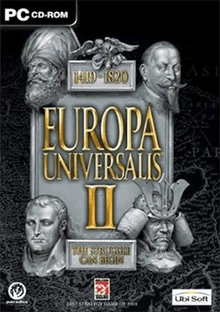Europa Universalis II
Europa Universalis II is a grand strategy game developed by Paradox Development Studio and published by Strategy First, based on world history spanning a timeline between 1419 through 1820. It was released on December 11, 2001.
| Europa Universalis II | |
|---|---|
 | |
| Developer(s) | Paradox Development Studio |
| Publisher(s) |
|
| Producer(s) | Peter Kullgard Fredrik Malmberg |
| Designer(s) | Johan Andersson Joakim Bergqwist |
| Programmer(s) | Johan Andersson |
| Artist(s) | Timo Väisänen |
| Engine | Europa Engine |
| Platform(s) | Microsoft Windows, Mac OS, Mac OS X |
| Release | |
| Genre(s) | Grand strategy |
| Mode(s) | Single player, multiplayer |
Gameplay
In the game, the player controls a single nation across five centuries, managing its economy, military, political alliances, scientific development, exploration and colonization, religious affairs, and internal stability. In addition, yearly random events, as well as hundreds of pre-scripted ones based on the historical record, make for a great deal of gameplay challenge and variety.
Europa Universalis II differs from many similar turn-based strategy games in that time flows continuously during gameplay, rather than taking place in discrete turns. The player is able to pause the action to ponder the situation and give orders, then speed up or slow down time to let events take their course.
The game ships with several historical scenarios, including games that take place during the Age of Exploration, the American Revolution, and the Napoleonic Wars. The Grand Campaign lets players choose one world power and guide it from the end of the Middle Ages and into the 19th century. There is also a Fantasy Scenario, starting in an unoccupied and unexplored earth with only 8 civilizations to choose. In this scenario, casual gameplay and strategy that should be applied are slightly different, more like a 4X game with a strong emphasis on colonization.
While the Grand Campaign is geared primarily towards the major European powers of the time, such as Austria, England, France, Poland, Portugal, Russia, Spain, Sweden, and Ottoman Empire, the game is unique in that players can choose to play as one of more than a hundred obscure, no longer existing nations, from the Indian subcontinent to the Balkans.
Development
The game, based on the Europa Engine, was developed by Paradox Interactive as a sequel to Europa Universalis, and was first released for the PC in 2001 by Strategy First, with a Macintosh port created by Virtual Programming and published by MacPlay. A Linux port was in development[1] but was not released.
Reception
| Reception | ||||||||||
|---|---|---|---|---|---|---|---|---|---|---|
| ||||||||||
Europa Universalis II was nominated for Computer Gaming World's 2002 "Strategy Game of the Year" award, which ultimately went to Freedom Force.[5] Europa Universalis II received "generally favourable" reviews according to review aggregator Metacritic.[6]
References
- "An Interview With A Linux Game Porter". Phoronix.
- Fletcher, John (April 2002). "Reviews; Europa Universalis II". Computer Gaming World (213): 100.
- O'Hagan, Steve (March 13, 2002). "Europa Universalis 2". PC Zone. Archived from the original on March 2, 2009. Retrieved August 12, 2019.
- Chick, Tom (March 1, 2002). "Back to the Past". Computer Games Magazine. Archived from the original on August 3, 2004. Retrieved August 12, 2019.
- Staff (April 2003). "Computer Gaming World's 2002 Games of the Year". Computer Gaming World (225): 83–86, 88, 89, 92–97.
- "Europa Universalis II". Metacritic. Retrieved 2018-04-17.